

The world's biomes. Online exhibits The world's biomes Biomes are defined as "the world's major communities, classified according to the predominant vegetation and characterized by adaptations of organisms to that particular environment" (Campbell 1996).
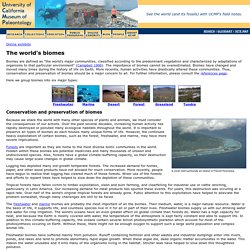
The importance of biomes cannot be overestimated. Biomes have changed and moved many times during the history of life on Earth. More recently, human activities have drastically altered these communities. The World's Biomes. WorldBiomes.com - Explore Five of the World's Main Biomes. Major Biomes of the world. It is important to know the inter-relationship between each of these elements in a biome.
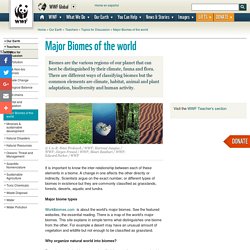
A change in one affects the other directly or indirectly. Scientists argue on the exact number, or different types of biomes in existence but they are commonly classified as grasslands, forests, deserts, aquatic and tundra. Major biome typesWorldbiomes.com is about the world's major biomes. See the featured websites, the essential reading. There is a map of the world's major biomes. Threats to Rainforests from Humankind. The greatest cause of tropical rainforest destruction today comes from human activities, which, unlike natural damage, are unrelenting and thorough.
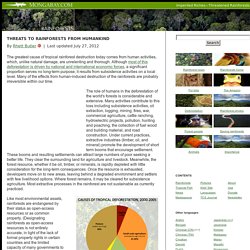
Although most of this deforestation is driven by national and international economic forces, a significant proportion serves no long-term purpose; it results from subsistence activities on a local level. Many of the effects from human-induced destruction of the rainforests are probably irreversible within our time. The role of humans in the deforestation of the world's forests is considerable and extensive.
Many activities contribute to this loss including subsistence activities, oil extraction, logging, mining, fires, war, commercial agriculture, cattle ranching, hydroelectric projects, pollution, hunting and poaching, the collection of fuel wood and building material, and road construction. Human Impact on the Mojave : Feature Articles. "Our goal is to create predictive models of the desert that land managers can use to forecast what is likely to happen to a specific piece of land, given its exposure to various types of disturbances," said Gaydos.
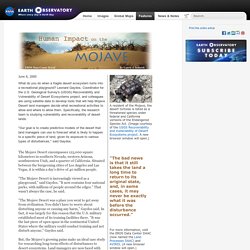
The Mojave Desert encompasses 125,000 square kilometers in southern Nevada, western Arizona, southwestern Utah, and a quarter of California. Situated between the burgeoning cities of Los Angeles and Las Vegas, it is within a day's drive of 40 million people. "The Mojave Desert is increasingly viewed as a playground," said Gaydos. "It now contains four national parks, with millions of people around the edges. " That wasn't always the case, he said. World of Change: Amazon Deforestation : Feature Articles. The state of Rondônia in western Brazil — once home to 208,000 square kilometers of forest (about 51.4 million acres), an area slightly smaller than the state of Kansas — has become one of the most deforested parts of the Amazon.
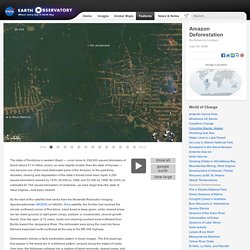
In the past three decades, clearing and degradation of the state’s forests have been rapid: 4,200 square kilometers cleared by 1978; 30,000 by 1988; and 53,300 by 1998. By 2003, an estimated 67,764 square kilometers of rainforest—an area larger than the state of West Virginia—had been cleared. By the start of this satellite time series from the Moderate Resolution Imaging Spectroradiometer (MODIS) on NASA’s Terra satellite, the frontier had reached the remote northwest corner of Rondônia. Intact forest is deep green, while cleared areas are tan (bare ground) or light green (crops, pasture, or occasionally, second-growth forest). World of Change: Shrinking Aral Sea : Feature Articles. In the 1960s, the Soviet Union undertook a major water diversion project on the arid plains of Kazakhstan, Uzbekistan, and Turkmenistan.
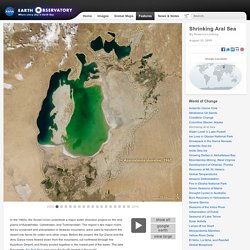
The region’s two major rivers, fed by snowmelt and precipitation in faraway mountains, were used to transform the desert into farms for cotton and other crops. Before the project, the Syr Darya and the Amu Darya rivers flowed down from the mountains, cut northwest through the Kyzylkum Desert, and finally pooled together in the lowest part of the basin. The Aral Sea Crisis. The Aral Sea is situated in Central Asia, between the Southern part of Kazakhstan and Northern Uzbekistan.
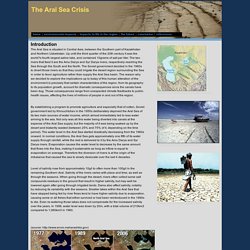
Up until the third quarter of the 20th century it was the world? S fourth largest saline lake, and contained 10grams of salt per liter. The two rivers that feed it are the Amu Darya and Syr Darya rivers, respectively reaching the Sea through the South and the North. The Soviet government decided in the 1960s to divert those rivers so that they could irrigate the desert region surrounding the Sea in order to favor agriculture rather than supply the Aral Sea basin. The reason why we decided to explore the implications up to today of this human alteration of the environment is precisely that certain characteristics of the region, from its geography to its population growth, account for dramatic consequences since the canals have been dug.
The Aral Sea environmental health crisis. Waiting for the sea. Khojabay is not the only one who looks daily “out to sea” across the desert.

Tara FitzGerald met another elderly former ship’s captain doing exactly the same - but 400km further south, in the one-time Uzbek port of Moynak. His children moved away in search of jobs and his wife died, and the town around him - complete with promenade overlooking the dry seabed - is now lifeless. The hulls of former fishing boats dot the horizon here too. Food & climate. Climate change is one of the biggest threats to ending global hunger.

We’re hungry for a fair climate and so are millions of people around the world. Extreme weather = extreme hunger. The Human Footprint : Feature Articles. These organisms share a common threat: human impact, usually in the form of habitat destruction, eradication efforts, overharvesting, and the introduction of invasive species.

Though conservationists have long been concerned about the impact of human activity, a lack of quantifiable data has historically hampered efforts to achieve conservation goals. “I’m convinced that we’re in a weird paradox,” said Marc Levy, co-project scientist at the Socioeconomic Data and Applications Center (SEDAC) at Columbia University. “The international community has finally started taking sustainable development seriously, but now ecosystem preservation is fading into the background.